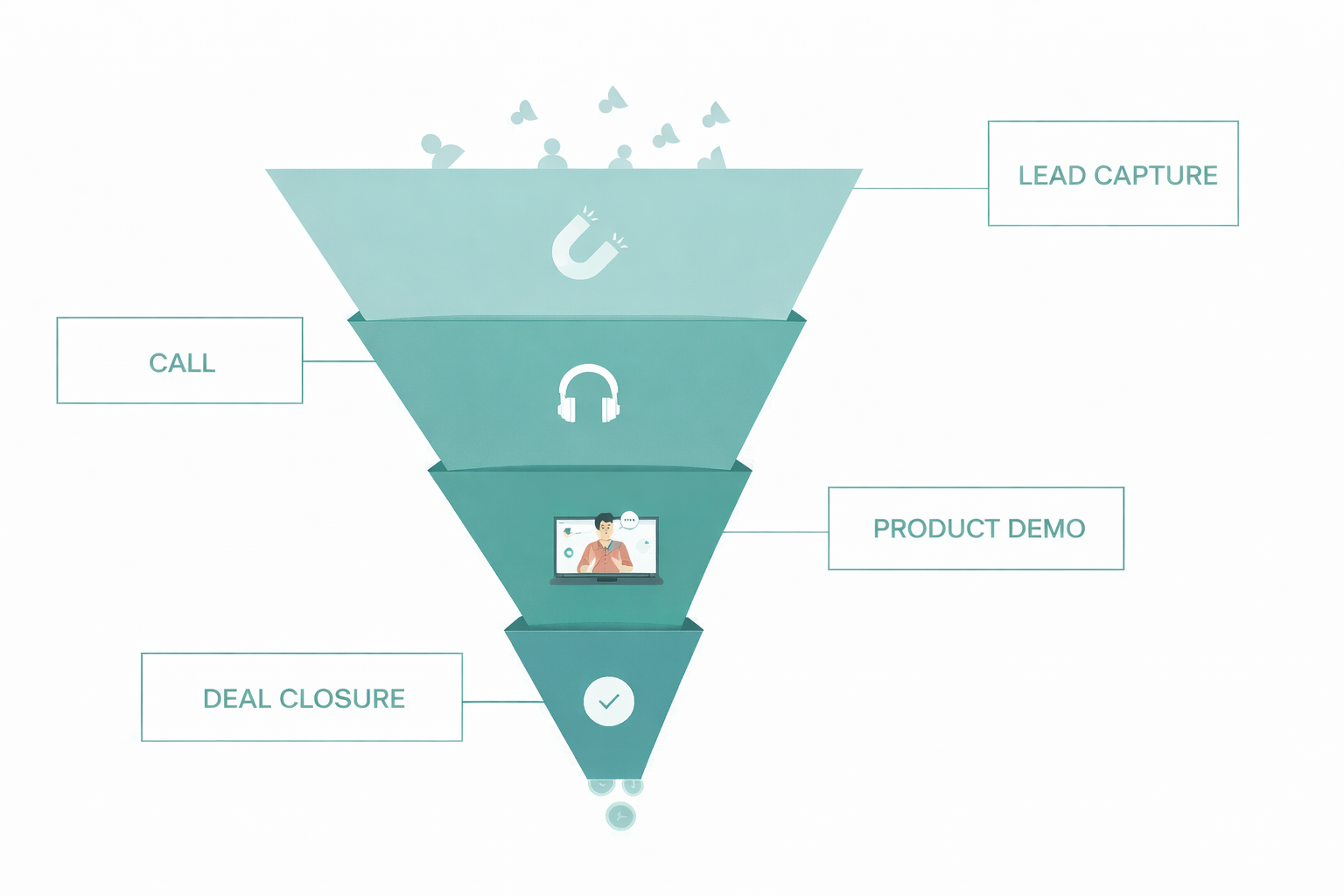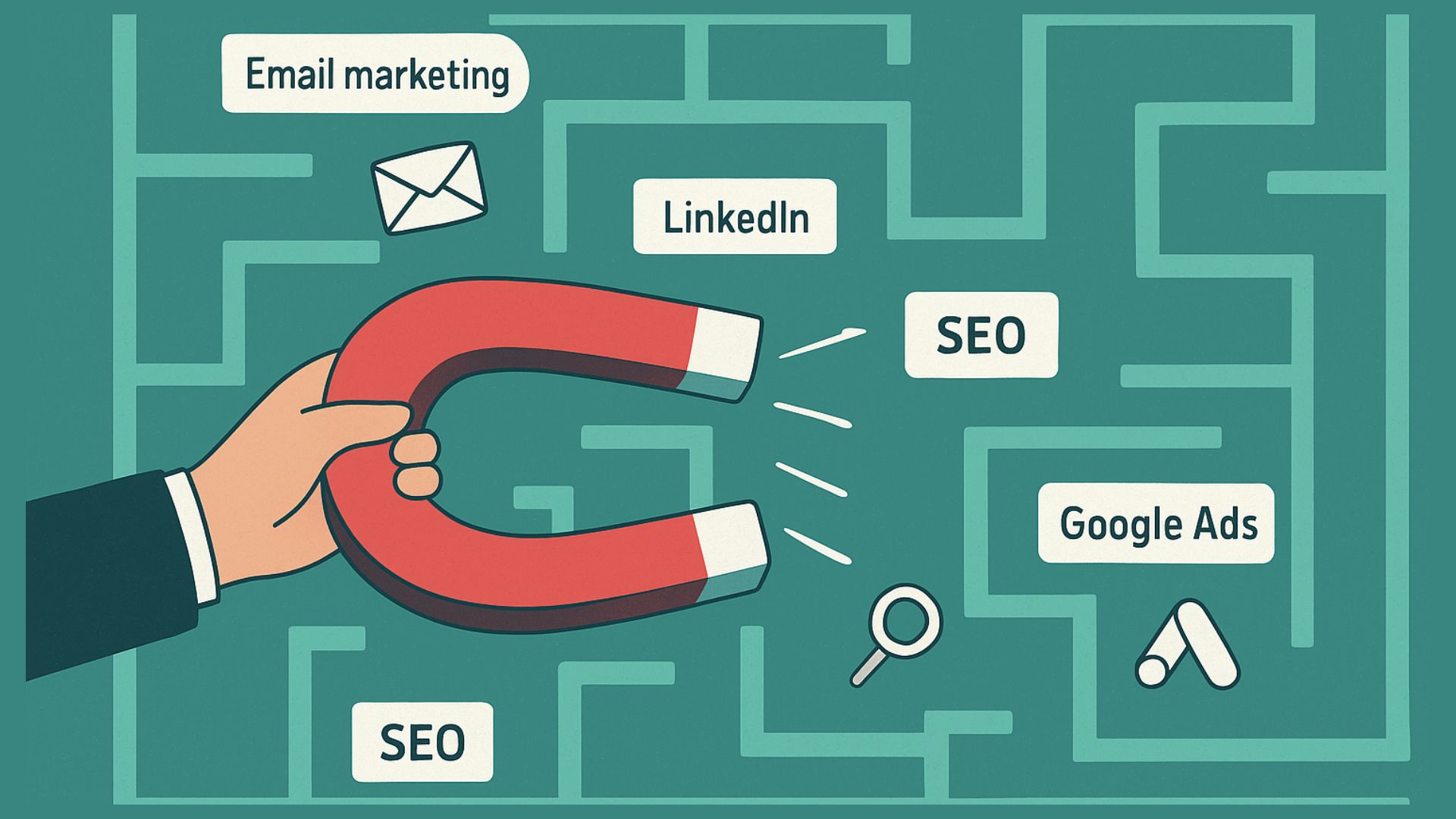

Inside sales is a sales approach where reps sell products or services remotely, using tools like phone, email, and video calls instead of in-person meetings. It allows businesses to reach more customers efficiently without the need for travel.
Let’s understand inside sales through the example of Elizabeth.
Elizabeth is an inside sales rep at a SaaS company. Her job is to connect with prospects and close deals remotely.
She starts her day reviewing leads in the CRM and prioritizing those with high intent. She begins outreach by setting up discovery calls and demos. On a typical video call, Elizabeth asks smart questions to understand the prospect’s pain points and tailors her pitch accordingly.
When a deal gets more technical, she brings in a pre-sales engineer for support. Throughout the day, she updates the CRM, tracks her pipeline, and collaborates with marketing and sales leaders to stay on target.
By the end of the day, Elizabeth has moved several deals forward without ever leaving her desk. Her story shows how inside sales drives results using digital tools.
Let’s understand inside sales in detail, shall we?
What is inside sales?

What are the advantages of inside sales?
- Cost-effective
- Higher reach
- Faster sales cycle; quicker decision making and faster follow-ups
- Quicker response times
- Easy to scale
- Increased flexibility in work environment
What are the main roles and responsibilities involved in inside sales?
- Managing, qualifying and nurturing leads
- Identifying and reaching out to prospects through emails, calls or social media
- Conducting virtual demos or presentations
- Staying informed about product features, benefits and other updates
- Discussing pricing, terms and conditions and closing deals via calls or email
- Building customer relationships
- Closing deals and sorting out the paperwork
- Collaborating with teams like marketing or field sales in order to close deals faster
Inside Sales vs Outside Sales
What are some inside sales tools?
CRM software
A CRM like Superleap acts as a central system for managing contacts, tracking deals and logging activities.
Sales engagement platforms
These help in conducting structured outreach through email sequences, call workflows, LinkedIn steps and reminders
Dialers and call recording tools
Auto dialers, click-to-call features and call recording help reps increase call volume and improve performance through call reviews.
Email automation and personalisation tools
These help create personalized templates, track open/reply rates and send automated follow-ups without manual effort.
Lead intelligence and prospecting tools
These provide company data, contact details and buying signals so reps can target the right leads and tailor conversations.
Conversion intelligence tools
These analyse sales calls, highlight keywords, track objections and provide coaching insights to improve pitch quality.
Proposal and eSignature tools
These allow reps to generate quotes, send proposals, and collect signatures digitally, speeding up the closing process.
What are some inside sales techniques?
- Prioritize leads with lead scoring
- Follow proven sales call scripts
- Conduct strong discovery calls
- Personalise every email
- Automate repetitive tasks
- Deliver focused virtual demos
- Track data to improve performance
What are the challenges involved in inside sales and how to overcome them?
Difficulty in building relationships
Without face-to-face interaction, it can be hard to build trust and rapport with prospects or customers.
Solution: Focus on active listening and personalise the convo whenever possible during phone calls or video meetings. Use tools like CRM to track customer preferences and tailor conversations according to their needs.
Lead generation and qualification
Finding high-quality leads can be time-consuming, and differentiating between leads that are truly ready to buy and those that are just interested can get tricky.
Solution: Invest in automation tools and lead-scoring systems that help identify high-potential prospects. Implement inbound marketing strategies and use data analytics to better understand customer behaviors.
Time management
Inside sales reps often have to juggle between multiple leads and tasks, making time management difficult.
Solution: Use a CRM system like Superleap to automate follow-ups, prioritize leads, and streamline tasks.
Maintaining engagement over long sales cycles
Sales cycles can be longer for some products or services, making it hard to keep prospects engaged.
Solution: Develop nurturing campaigns using email sequences, follow-up calls, and relevant content that keep prospects engaged. Use marketing automation to send personalized content at significant points in the sales cycle.
Communication barriers
Without in-person communication, there is potential for misunderstanding or lack of clarity, especially if there are language or cultural barriers.
Solution: Use clear and concise language for communication and use visuals (like presentations or demos) to ensure that the prospect/customer doesn’t miss out on key aspects. Additionally, send minutes of the meeting after calls to ensure everyone is on the same page.
Technology overload
Relying heaving on technology can become overwhelming or lead to inefficiencies if not managed well.
Solution: Streamline tech tools by using a CRM software like Superleap that offers seamless third party integration.
Competition with other teams or channels
Inside sales teams may face competition from field sales or other marketing efforts, leading to confusion or overlap.
Solution: Define clear roles and responsibilities within the sales process. Ensure alignment between inside and field sales teams, creating collaboration rather than competition. Maintain consistent messaging across all channels.
Data overload
Inside sales teams generate a lot of data which can be overwhelming to manage.
Solution: Use analytics tools to track key metrics, analyse trends and focus on actionable insights rather than drowning in raw data. Regularly review and adjust sales strategies based on data driven decisions.
What are the best practices for effective inside sales?
Master your sales pitch
- Craft a clear and compelling sales pitch that highlights your product’s benefits.
- Tailor your pitch to each prospect's unique challenges and needs.
Time management and prioritization
- Organize your day by prioritizing the most promising leads and focusing on activities that drive sales.
- Use scheduling tools to streamline meetings and follow-ups, keeping you on track.
Seek feedback and adapt your approach accordingly
- Regularly assess your performance, seek feedback, and refine your sales tactics.
- Stay updated on new tools, techniques, and industry trends to improve your skills.
Work on your communication skills
- Improve your written and verbal communication skills to engage effectively with prospects.
- During conversations, avoid using jargon or overly complicated language that might confuse the prospect.
Practice transparency with customers
- Build trust by being transparent and honest about what your product can and cannot do. Making false promises can damage customer relationships and hinder sales.
Don’t take rejection to heart
- Rejection is inevitable in sales, use it as a learning experience and don’t take it personally.
Use effective closing techniques
- Understand when a prospect is ready to close and be confident in asking for the sale.
- Use closing strategies like urgency, scarcity, loss aversion etc. to motivate the prospect to make a decision.
Collaborate with other teams
- Work closely with marketing, customer service and other departments to ensure that you’re well aligned on messaging, lead qualification, and follow-up strategies.
- Share insights with other departments to refine approaches and improve results across teams.
Offer value as often as possible
- Regularly check in with leads and customers to provide relevant content, updates, or tips that can help solve their ongoing challenges.
- Offering value in every interaction keeps the relationship strong and ensures that you're seen as a helpful advisor, not just a salesperson.
Stay organized
- Use task management tools or to-do lists to keep track of priorities, follow-ups, and deadlines.
What are some examples where inside sales is used?
SaaS companies
Companies like Zoom use inside sales teams to sell premium subscriptions remotely. Reps contact leads via email or phone, demonstrate product features through virtual demos, and finalize subscriptions online.
E-commerce B2B Sales
At Shopify, sales reps reach out to small businesses that sign up for free trials. They explain key features, offer tailored recommendations, and encourage upgrading to paid plans via email or chat.
Financial services
At QuickBooks, inside sales teams sell accounting software to small businesses. Reps demonstrate features like payroll and invoicing during remote calls and finalize subscriptions online.
Education and EdTech companies
Coursera sales reps contact universities to sell access to online learning platforms. They showcase benefits in virtual meetings and close deals using digital contracts and payments.
Recruitment and HR platforms
At LinkedIn, sales teams sell premium tools like Sales Navigator to recruiters and businesses. Reps identify leads, explain features in remote demos, and finalize subscriptions digitally.
Online marketing services
Superleap uses inside sales to sell CRM and marketing tools. Reps contact businesses, highlight features like lead generation, third party integration, AI features etc. to onboard customers remotely.
Conclusion
Inside sales is no longer just a backup for traditional field sales—it’s become a powerful, primary strategy for modern businesses. It combines efficiency, scalability, and digital convenience to help sales teams connect with more prospects, faster.
Yes, it comes with its own set of challenges like building rapport virtually or juggling multiple tools but with the right approach, these hurdles are easy to overcome. By embracing best practices, staying organized, and putting the customer first, inside sales teams can consistently deliver results.
As remote and hybrid work reshape how we do business, inside sales has taken center stage. It’s the way forward for teams looking to work smarter, close faster, and scale without the extra cost.
ARE YOU SUITED FOR INSIDE SALES? TAKE THE QUIZ!
Heading text
Nunc sed faucibus bibendum feugiat sed interdum. Ipsum egestas condimentum mi massa. In tincidunt pharetra consectetur sed duis facilisis metus. Etiam egestas in nec sed et. Quis lobortis at sit dictum eget nibh tortor commodo cursus.
Odio felis sagittis, morbi feugiat tortor vitae feugiat fusce aliquet. Nam elementum urna nisi aliquet erat dolor enim. Ornare id morbi eget ipsum. Aliquam senectus neque ut id eget consectetur dictum. Donec posuere pharetra odio consequat scelerisque et, nunc tortor.
Nulla adipiscing erat a erat. Condimentum lorem posuere gravida enim posuere cursus diam.
.svg)






